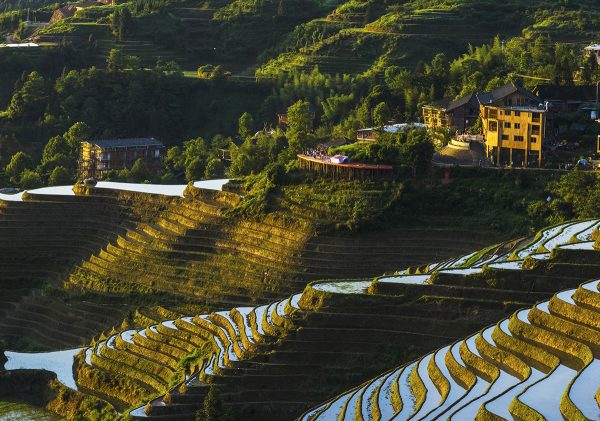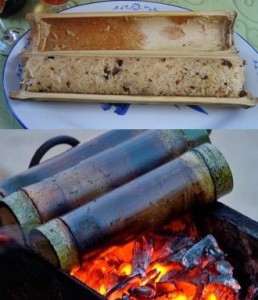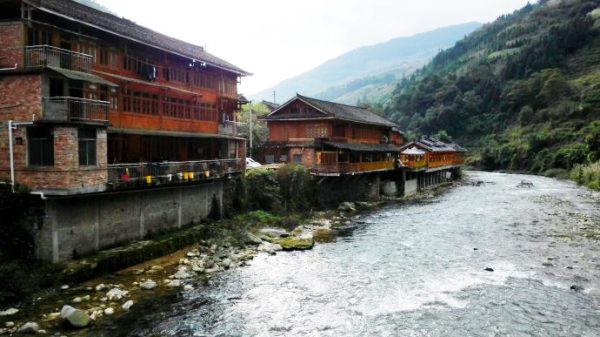
The Jinkeng Terraces are the lesser known, less tourist oriented portion of the Longji Rice Terraces Scenic Area. Jinkeng is made up of several small villages, including Dazhai, Tiantou, Zhuangjie, Xinzhai and Xiaozhai, with Dazhai and Tiantou being considered the most scenic. The Jinkeng portion of the rice terraces is actually much larger than that of Ping’an village or Longji Ancient Zhuang Village but, because of the poor condition of the roads leading into the villages, it has yet to become as popular with tourists. The Jinkeng Terraces stretch up the mountains from 800 metres to a colossal 1,180 metres above sea level and their highest mountain, Fupingbao, is 1,900 metres at its peak. The hiking opportunities in Jinkeng are tremendous and we strongly recommend anyone looking for an adventure holiday in the rice terraces to opt for the villages of Dazhai or Tiantou as their base.
The main scenic spots in Jinkeng are Xishan Shaoyue or “Musical West Hill”, Dajie Thousand-Layer Terraces, and Golden Buddha Peak. Xishan Shaoyue is the first viewing platform on the mountains and offers a wonderful vantage point of the rice terraces. It is the easiest of the three scenic spots to get to and should only take about 2 hours to reach on foot. It’s a superb place to watch the sun rise and set over the rice terraces and it offers the broadest view of the Jinkeng Terraced Fields. Dajie Thousand-Layer Terraces is near to Xishan Shaoyue and there is a well-kept path on a gentle gradient leading to it so it is fairly easy to reach on foot. This area is particularly impressive due to the sheer number of rice terraces carved out of the mountains below, which perfectly exhibit the industrious work of the farmers who built them. It also offers an ideal view of the Yao villages below and is considered the perfect place to watch the sunrise.
Golden Buddha Peak is the only scenic spot that has cable car access in the Longji Scenic Area and this is simply because it is so far away! The cableway is about 1,580 metres long and takes just 20 minutes to reach the peak, although you do have to pay extra to ride the cable car. Otherwise, it’s about a 3 hour hike to reach the top, but this hike does reward you with stunning views of the rice terraces as you ascend the mountain. Golden Buddha Peak is considered the best scenic spot in Jinkeng and offers the most spectacular views of the rice terraces, particularly at sunset. If you’re feeling adventurous or you’re making an overnight stay in Dazhai or Tiantou, we strongly recommend taking the hike up the Golden Buddha Peak. Trust us, watching the sun set across the cascading mountains is a more than suitable reward.
The Jinkeng Red Yao Terraces are so named because the majority of the villages in the Jinkeng area are home to the Red Yao ethnic minority. These are a branch of the Yao ethnic minority that are named for their traditional dress. On festival occasions, the Red Yao women will wear a vibrant red coat and black pleated skirt, hence the name “Red” Yao. Yao women are also famous for growing their hair long and the best place to witness this unusual tradition is in nearby Huangluo Village.
The best time to visit the Jinkeng Rice Terraces is between April and late October, as this is when the farmers will be planting the rice. Each season affords different views of the rice terraces, so choose when you want to go carefully!
Dazhai (大寨)
“Dazhai” literally means “Large Village” in Chinese and, unsurprisingly, Dazhai is one of the largest villages in the Jinkeng area. Over 1,000 people live in the village of Dazhai and over 98% of them are from the Yao ethnic minority. Dazhai is far less crowded than Ping’an but is still reasonably well-equipped for tourism. There are just over 30 hotels and hostels in Dazhai and a number of restaurants. Although these hotels tend to be wooden and are not equipped with as many modern amenities as those in Ping’an, they offer a far more rustic feel and make you feel as though you are truly part of the village. On top of visiting the rice terraces, many of the local Yao people in Dazhai will gladly welcome you into their home and offer a glimpse of their simple, rural lifestyle.
Tiantou (田头)
“Tiantou” literally means “Head of the Fields” or “Farms” in Chinese and this aptly demonstrates the rustic atmosphere of this small village. Although Tiantou is smaller than Dazhai, it is located far closer to Xishan Shaoyue and Dajie Thousand-Layer Terraces. There are a handful of hotels in Tiantou, which make it the perfect place for an overnight stay should you wish to catch the sunrise at either of these scenic spots.
Quanjinglou or “Panorama Lodge” is considered to be the best hotel in the Jinkeng area and can be reached from both Dazhai and Tiantou. It is located not far from the Xishan Shaoyue scenic spot and has 26 rooms, which all offer outstanding views of the rice terraces.
Like Ping’an, the local cuisine in Dazhai and Tiantou is simple. Popular local dishes include bamboo-tube rice, smoked bacon fried with bamboo shoots, braised chicken, and fresh vegetables fried in oil. Many of the ingredients for the dishes will be locally sourced and taste incredibly fresh. A handful of restaurants and guesthouses in the area will offer some simple Western food, such as pizza or French fries.
How To Get There
You first need to take the express bus from Guilin to Longsheng County Town, which takes about 2 hours. The buses between Guilin and Longsheng are very regular and usually run at 15 minute intervals. In Longsheng you’ll need to purchase your tickets for the rice terraces. From Longsheng, you’ll need to take a bus to Dazhai Parking Lot, which can take up to 2 hours. At the parking lot, you can either make the short walk to Dazhai or walk to Tiantou, which takes about half an hour. Please be advised that the last bus back to Longsheng leaves from Dazhai Parking Lot at 4pm every day, so if you’re taking a daytrip to the rice terraces then you should aim to arrive and leave early.

